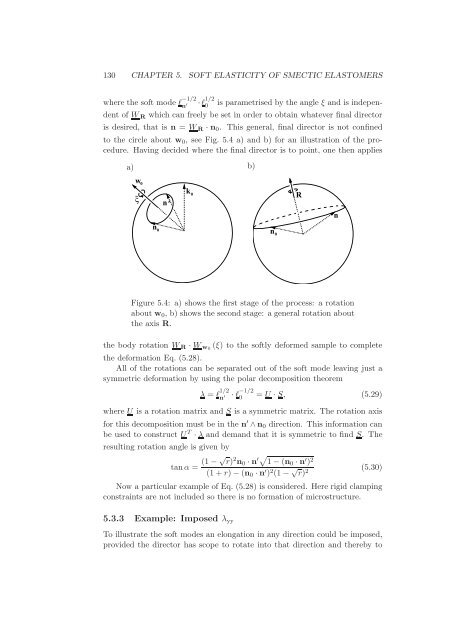Statistical models of elasticity in main chain and smectic liquid ...
Statistical models of elasticity in main chain and smectic liquid ...
Statistical models of elasticity in main chain and smectic liquid ...
You also want an ePaper? Increase the reach of your titles
YUMPU automatically turns print PDFs into web optimized ePapers that Google loves.
130 CHAPTER 5. SOFT ELASTICITY OF SMECTIC ELASTOMERSwhere the s<strong>of</strong>t mode l −1/2n ′ ·l 1/20 is parametrised by the angle ξ <strong>and</strong> is <strong>in</strong>dependent<strong>of</strong> W R which can freely be set <strong>in</strong> order to obta<strong>in</strong> whatever f<strong>in</strong>al directoris desired, that is n = W R · n 0 . This general, f<strong>in</strong>al director is not conf<strong>in</strong>edto the circle about w 0 , see Fig. 5.4 a) <strong>and</strong> b) for an illustration <strong>of</strong> the procedure.Hav<strong>in</strong>g decided where the f<strong>in</strong>al director is to po<strong>in</strong>t, one then appliesa)b)w 0n 0k 0ξn’Rnn 0Figure 5.4: a) shows the first stage <strong>of</strong> the process: a rotationabout w 0 , b) shows the second stage: a general rotation aboutthe axis R.the body rotation W R · W w0 (ξ) to the s<strong>of</strong>tly deformed sample to completethe deformation Eq. (5.28).All <strong>of</strong> the rotations can be separated out <strong>of</strong> the s<strong>of</strong>t mode leav<strong>in</strong>g just asymmetric deformation by us<strong>in</strong>g the polar decomposition theoremλ = l 1/2n ′ ·l −1/20 = U ·S, (5.29)where U is a rotation matrix <strong>and</strong> S is a symmetric matrix. The rotation axisfor this decomposition must be <strong>in</strong> the n ′ ∧n 0 direction. This <strong>in</strong>formation canbe used to construct U T ·λ <strong>and</strong> dem<strong>and</strong> that it is symmetric to f<strong>in</strong>d S. Theresult<strong>in</strong>g rotation angle is given bytanα = (1−√ r) 2 n 0 ·n ′√ 1−(n 0 ·n ′ ) 2(1+r)−(n 0 ·n ′ ) 2 (1− √ r) 2 (5.30)Now a particular example <strong>of</strong> Eq. (5.28) is considered. Here rigid clamp<strong>in</strong>gconstra<strong>in</strong>ts are not <strong>in</strong>cluded so there is no formation <strong>of</strong> microstructure.5.3.3 Example: Imposed λ yyTo illustrate the s<strong>of</strong>t modes an elongation <strong>in</strong> any direction could be imposed,provided the director has scope to rotate <strong>in</strong>to that direction <strong>and</strong> thereby to
















